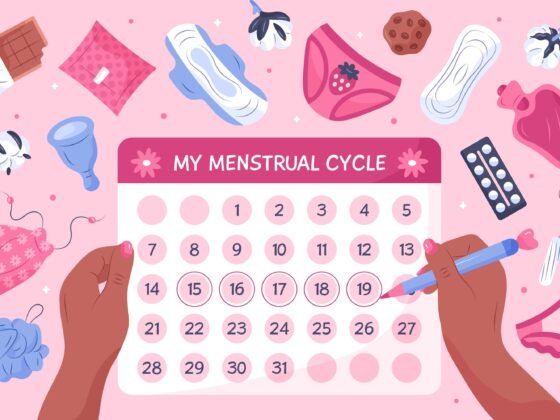Introduction to Ovulation and Its Importance in Fertility
Ovulation is a fundamental aspect of female reproductive health and a crucial component of fertility. This natural process, which occurs during a woman’s menstrual cycle, involves the release of a mature egg from one of the ovaries, making it available for fertilisation. Understanding the intricacies of ovulation is essential for couples who are trying to conceive, as well as for individuals seeking to better manage their reproductive health.
Ovulation plays a pivotal role in the reproductive process, as it provides the necessary opportunity for sperm to fertilise the egg, leading to the potential for pregnancy. By comprehending the mechanisms behind ovulation and its relation to the menstrual cycle, individuals can make informed decisions about their fertility and take proactive steps to optimise their chances of conception or, if desired, avoid pregnancy.
How Does Ovulation Work?
The ovulation process is regulated by a complex interplay of hormones, primarily involving the hypothalamus, pituitary gland, and ovaries. During a typical menstrual cycle, the hypothalamus releases gonadotropin-releasing hormone (GnRH), which stimulates the pituitary gland to secrete follicle-stimulating hormone (FSH) and luteinizing hormone (LH). These hormones, in turn, trigger the development and maturation of a dominant follicle within one of the ovaries.
As the follicle matures, it produces increasing amounts of the hormone estrogen. This surge in estrogen levels triggers the pituitary gland to release a surge of LH, known as the “LH surge.” The LH surge is the primary signal for the ovary to release the mature egg, a process known as ovulation. After the egg is released, the remaining follicular tissue transforms into the corpus luteum, which produces the hormone progesterone to prepare the uterine lining for potential implantation of a fertilised egg.
Signs and Symptoms of Ovulation
Recognising the signs and symptoms of ovulation can be helpful for individuals who are trying to conceive or manage their reproductive health. Some common signs and symptoms of ovulation include:
- Basal Body Temperature (BBT) Changes: The body’s basal temperature typically rises slightly (approximately 0.5-1°C or 0.9-1.8°F) after ovulation, as progesterone production increases.
- Cervical Mucus Changes: The consistency and appearance of cervical mucus changes throughout the menstrual cycle. Around the time of ovulation, the mucus becomes more clear, slippery, and stretchy, resembling raw egg white.
- Mittelschmerz: Some women experience a mild, one-sided abdominal pain or discomfort around the time of ovulation, known as mittelschmerz.
- Breast Tenderness: Increased breast sensitivity or tenderness may occur in the days leading up to and during ovulation.
- Increased Libido: Many women report an increased sexual desire around the time of ovulation, which is believed to be a biological response to facilitate conception.
- Ovulation Test Results: Ovulation prediction kits, which detect the LH surge, can provide a reliable indication of the impending ovulation event.
Tracking Your Ovulation Cycle
Monitoring and tracking your ovulation cycle can be a valuable tool for individuals who are trying to conceive or manage their reproductive health. There are several methods available for tracking ovulation, including:
- Basal Body Temperature (BBT) Charting: Recording your basal body temperature daily and observing the characteristic rise after ovulation can help identify the fertile window.
- Cervical Mucus Monitoring: Observing and recording the changes in cervical mucus consistency and appearance can provide insights into the stages of the menstrual cycle and the fertile window.
- Ovulation Prediction Kits: These at-home tests detect the LH surge, which typically occurs 12-36 hours before ovulation, allowing individuals to identify the optimal time for intercourse.
- Fertility Tracking Apps: Numerous mobile applications are available that can assist in tracking ovulation, menstrual cycles, and other reproductive health parameters.
- Ovulation Monitors: Some advanced devices, such as digital ovulation monitors, can measure and interpret hormonal changes to pinpoint the most fertile days.
By combining multiple tracking methods, individuals can gain a more comprehensive understanding of their unique ovulation patterns and fertility.
Understanding the Menstrual Cycle and Its Relation to Ovulation
The menstrual cycle is a complex, cyclical process that is intimately linked to ovulation. The average menstrual cycle length is approximately 28 days, although individual variations are common. The cycle can be divided into several phases, each with its own hormonal changes and physiological events:
- Menstrual Phase: This phase begins with the onset of menstrual bleeding, which typically lasts 3-7 days.
- Follicular Phase: During this phase, the pituitary gland releases FSH, stimulating the development of a dominant follicle in the ovary. Estrogen levels rise during this phase.
- Ovulatory Phase: The LH surge triggers the release of the mature egg from the dominant follicle, a process known as ovulation.
- Luteal Phase: After ovulation, the remaining follicular tissue transforms into the corpus luteum, which produces progesterone to prepare the uterine lining for potential implantation.
Understanding the various phases of the menstrual cycle and their relation to ovulation is crucial for individuals who are trying to conceive or manage their reproductive health.
Factors That Can Affect Ovulation
Numerous factors can influence the timing and regularity of ovulation, including:
- Age: Ovulation patterns may change as a woman ages, with some women experiencing irregular or absent ovulation as they approach menopause.
- Stress: High levels of stress can disrupt the delicate hormonal balance, potentially leading to irregular or missed ovulation.
- Weight: Both underweight and overweight/obese individuals may experience issues with ovulation due to hormonal imbalances.
- Medications: Certain medications, such as hormonal birth control, antidepressants, and chemotherapeutic agents, can impact ovulation.
- Medical Conditions: Conditions like polycystic ovary syndrome (PCOS), thyroid disorders, and endometriosis can interfere with normal ovulation patterns.
- Lifestyle Factors: Factors such as diet, exercise, and substance use (e.g., alcohol, tobacco) can also affect ovulation.
Understanding the potential impact of these factors can help individuals take proactive steps to optimise their reproductive health and fertility.
Ovulation and Fertility: How They Are Connected
Ovulation is a crucial component of fertility, as it provides the necessary opportunity for sperm to fertilise the released egg, potentially leading to pregnancy. The “fertile window,” which is the time during the menstrual cycle when a woman is most likely to conceive, typically spans from a few days before ovulation to the day of ovulation.
During this fertile window, the cervical mucus becomes more hospitable for sperm, and the egg is available for fertilisation. Intercourse during this time increases the likelihood of conception. Conversely, having sexual intercourse outside of the fertile window significantly reduces the chances of pregnancy.
Understanding the connection between ovulation and fertility can empower individuals to make informed decisions about their reproductive health, whether they are trying to conceive or seeking to avoid pregnancy.
Common Misconceptions about Ovulation
Despite the importance of ovulation in fertility and reproductive health, there are several common misconceptions that often persist:
- Myth: Ovulation occurs on the 14th day of the cycle: While this may be true for some individuals, the timing of ovulation can vary greatly from person to person and even from cycle to cycle.
- Myth: You can only get pregnant during ovulation: In reality, the fertile window extends a few days before and after ovulation, as sperm can survive in the female reproductive tract for up to 5 days.
- Myth: Irregular periods mean you’re not ovulating: Irregular menstrual cycles do not necessarily indicate a lack of ovulation. Some women with irregular cycles may still ovulate, albeit at varying intervals.
- Myth: Ovulation pain is a reliable sign of ovulation: While some women do experience mittelschmerz, the absence of this pain does not necessarily mean that ovulation has not occurred.
Addressing these misconceptions and promoting accurate understanding of ovulation can help individuals make more informed decisions about their reproductive health and fertility.
Tips for Optimizing Fertility through Understanding Ovulation
By gaining a deeper understanding of ovulation and its role in fertility, individuals can take proactive steps to optimise their chances of conception. Here are some tips:
- Track Your Ovulation Cycle: Utilize a combination of methods, such as BBT charting, cervical mucus monitoring, and ovulation prediction kits, to identify your unique ovulation patterns.
- Time Intercourse Appropriately: Engage in sexual intercourse during the fertile window, which typically spans from a few days before ovulation to the day of ovulation.
- Maintain a Healthy Lifestyle: Adopt a balanced diet, engage in regular exercise, manage stress, and avoid substances that can negatively impact fertility.
- Address Underlying Conditions: If you have a medical condition that may affect ovulation, such as PCOS or thyroid disorders, work with your healthcare provider to manage it.
- Consider Ovulation-Enhancing Supplements: Certain supplements, like vitamin B6, omega-3 fatty acids, and antioxidants, may support ovulation and fertility, but consult your healthcare provider before use.
- Seek Professional Guidance: If you are experiencing difficulty conceiving or have concerns about your ovulation patterns, don’t hesitate to consult a fertility specialist or reproductive endocrinologist.
By understanding and proactively addressing the factors that influence ovulation, individuals can take steps to optimise their fertility and reproductive health.
Seeking Professional Help for Ovulation and Fertility Issues
In some cases, individuals may require professional assistance to address ovulation and fertility-related concerns. Healthcare providers, such as obstetricians, gynecologists, and reproductive endocrinologists, can provide comprehensive evaluation and tailored treatment plans.
Some common reasons to seek professional help include:
- Irregular or absent ovulation: Conditions like PCOS, thyroid disorders, or other underlying health issues may require medical intervention to regulate ovulation.
- Difficulty conceiving: If a couple has been trying to conceive for a year or more (or 6 months for those over the age of 35), seeking the guidance of a fertility specialist can be beneficial.
- Recurrent pregnancy loss: Repeated miscarriages may be linked to ovulation or other fertility-related factors, warranting a thorough medical assessment.
- Suspected hormonal imbalances: Unexplained symptoms, such as severe menstrual cramps, excessive hair growth, or acne, may indicate an underlying hormonal issue that requires professional evaluation.
By working closely with healthcare providers, individuals can obtain a comprehensive understanding of their reproductive health, identify any underlying issues, and explore appropriate treatment options to optimise their chances of achieving a successful pregnancy.
Conclusion
Ovulation is a vital aspect of female reproductive health and a crucial component of fertility. By understanding the mechanisms behind ovulation, recognising the signs and symptoms, and tracking the menstrual cycle, individuals can make informed decisions about their reproductive health and fertility.
Factors such as age, stress, weight, and medical conditions can impact ovulation, highlighting the importance of maintaining a healthy lifestyle and seeking professional guidance when necessary. Addressing common misconceptions and empowering individuals with accurate knowledge can help them take proactive steps to optimise their fertility and achieve their reproductive goals.
If you’re looking to better understand your ovulation cycle and improve your fertility, consider consulting with a reproductive healthcare provider. They can help you develop a personalized plan to support your reproductive health and increase your chances of conception. Don’t hesitate to take the first step towards achieving your family-building goals.





